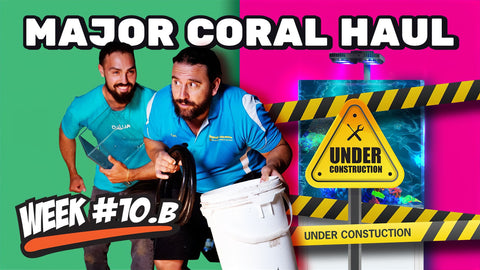Fastest Way To Cycle Your Reef Tank | 12 Week Reef Video Tutorial #5
Starting a Reef Tank: Fine-Tuning Skimmers and Cycle Your Aquarium Faster
When you're starting a reef tank, understanding how to fine-tune your equipment is key to maintaining a healthy environment. Pumps, wave makers, and protein skimmers are essential pieces of wet equipment that play a vital role in your tank’s life support system. This guide will walk you through fine-tuning your setup, from tuning your protein skimmer to setting up your wave makers, ensuring your tank thrives from the start.
Getting Started
In the first few weeks after starting a reef tank, your hands will be in and out of the water frequently. You'll be adding fish, corals, and ensuring your tank’s biological ecosystem stabilizes. During this time, you may encounter the “ugly phase,” a normal part of cycling a tank, where a film starts to spread over the rocks and sand. Don’t worry—this is where your clean-up crew comes in handy to help clean the tank while your nitrogen cycle gets established (more on that below).
Fine-Tuning Your Great White Protein Skimmer
One of the most important tasks when starting a reef tank is to properly tune your protein skimmer. Protein skimmers help remove proteins, organics, and waste from your tank by creating fine bubbles that carry these substances into the waste collection cup. In the early weeks, your skimmer may not collect much waste, but it’s crucial to set it up correctly so it’s ready when needed.
Here are three ways to fine-tune your protein skimmer:
- Air Intake: Too much air will result in violent water flow, bursting bubbles and reducing skimming efficiency. You want calm bubbles that don’t pop as they carry waste into the collection cup. Start by fully closing your air intake on the neck of your Great White Skimmer, and then slowly open the air intake quarter turn at a time.
- Pump Speed: Set your pump to around 12-14 for a gentle water flow. This prevents aggressive bubbles, ensuring they carry waste effectively. This is not a concrete number. Set it enough so that the top of the bubbles inside of the protein skimmer is sitting around the neck level.
- Discharge Pipe: Adjusting this will either raise or lower the water inside the skimmer. A more open discharge means drier skimming (less water inside) and possibly more microbubbles, while a closed discharge means wetter skimming with fewer microbubbles (high internal water level).
Fine-tuning these aspects ensures your skimmer operates efficiently, especially in the early weeks of starting a reef tank when your levels fluctuate.
Managing Wave Makers
Wave makers create essential water flow in your tank, which is crucial for overall tank health. In a smaller setup, good flow is easier to achieve, and your aquascape can help the water circulate efficiently. It's vital to adjust your wave maker to prevent stagnant areas and ensure that your corals and fish receive the proper flow they need. We suggest to turn up flow as high as possible but also to make sure your corals are reacting well and not retracting from too strong a flow.
Introducing the Clean-Up Crew and Cycling Your Reef Tank
After tuning your protein skimmer and wave maker, it’s time to address the nitrogen cycle. Establishing this is essential for your reef tank's health, but waiting for the cycle to complete can take time. A quick way to jumpstart the process is by introducing cycled biological media from your LFS (local fish store) along with 3 or 4 clean-up crew per 200L of aquarium water. These critters—like snails and crabs—not only help keep your tank clean but also contribute to the nitrogen cycle, speeding up the process. If you can't get any cycled media from your LFS then do not add any livestock.
When you're ready to add the clean-up crew, be sure to acclimate them properly. Making sure their water parameters match your aquariums paramters. If they do not, slowly introduce aquarium water to your clean up crews bag over a 1 to 2 hour period. Start with a low bioload, meaning a few critters, and gradually increase as the nitrogen cycle stabilizes. You’ll also get the added benefit of your new critters eating the algae from the "ugly stage" that every new aquarium goes through.
Testing Water Levels
Throughout these first few weeks, consistently testing levels in your reef tank is critical. Keep an eye on parameters such as ammonia, nitrites, and nitrates to ensure the nitrogen cycle is progressing and your water is safe for future additions of fish and corals. Testing regularly helps prevent any unexpected issues and allows for quick adjustments to equipment or water chemistry. If you notice absolutely any ammonia or nitrites you must immediately remove all livestock.
Saltwater Aquarium Best Start Guide
In the coming weeks, we’ll dive into topics like:





